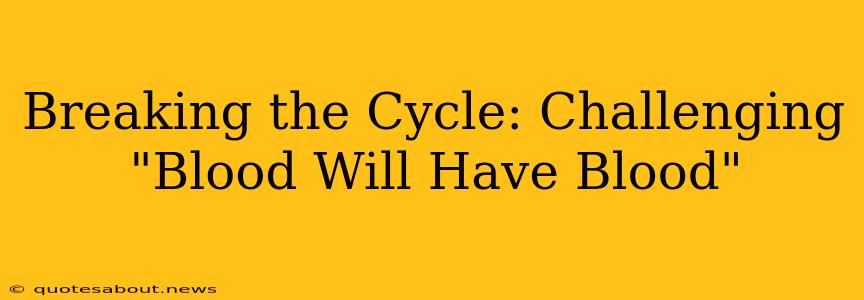The phrase "blood will have blood" echoes through history, literature, and even modern-day discourse. It suggests an inescapable cycle of violence, a grim inevitability where bloodshed begets more bloodshed. But is this truly an immutable law, or can we, as individuals and societies, break free from this destructive pattern? This exploration delves into the origins of this idea, its manifestations in different contexts, and, most importantly, the pathways toward challenging and ultimately overcoming its pervasive influence.
What Does "Blood Will Have Blood" Actually Mean?
The phrase itself carries a weighty implication: a retributive justice, a sense that violence is not only justified but also inherently unavoidable when confronted with bloodshed. It speaks to a primal instinct for revenge, a deeply ingrained human response to loss and suffering. The origin of the exact phrase is debated, with some tracing it to Shakespeare's Titus Andronicus, though similar sentiments are found throughout literature and mythology. However, the core meaning remains consistent: violence breeds more violence.
How Does This Mentality Manifest Itself?
The "blood will have blood" mentality manifests in various ways, from personal vendettas to large-scale conflicts:
-
Personal Revenge: A common example is the cycle of violence within families or communities, where an initial act of aggression triggers a retaliatory response, leading to escalating conflict. This can take the form of feuds lasting generations.
-
Societal Conflicts: On a larger scale, this principle can be seen in the context of protracted wars and conflicts. Each act of violence fuels further aggression, creating a seemingly endless cycle of bloodshed. Think of historical conflicts or even contemporary geopolitical tensions, where past grievances often fuel current animosities.
-
Justice Systems: Even within formal justice systems, the concept can subtly influence approaches. While justice often demands accountability for violence, an overemphasis on retribution—rather than rehabilitation or restorative justice—can inadvertently perpetuate the cycle.
Why is breaking this cycle so difficult?
This is a crucial question, and its answer is multifaceted. Breaking the cycle demands confronting deeply ingrained human emotions and societal structures:
-
Emotional Responses: Anger, grief, and a desire for retribution are powerful emotions that can override rational decision-making. These powerful emotions fuel a desire for revenge, making it difficult to break free from the cycle of violence.
-
Societal Structures: In some societies, cultural norms and traditions might normalize or even glorify violence, further reinforcing the "blood will have blood" mentality. This can make it particularly challenging to challenge the existing power dynamics.
Can We Break the Cycle of Violence? What are some strategies?
While the challenge is significant, breaking the cycle is not impossible. It requires a multi-pronged approach that tackles both the individual and societal levels:
-
Promoting Empathy and Understanding: Cultivating empathy and understanding towards those who have inflicted harm is crucial. This doesn’t mean condoning violence, but rather acknowledging the complex factors—often including trauma, poverty, or systemic oppression—that can contribute to violent acts.
-
Focusing on Restorative Justice: Restorative justice practices emphasize repairing harm caused by criminal behavior, rather than solely focusing on punishment. These practices bring together victims, offenders, and community members to address the underlying causes of the conflict and find ways to heal and move forward.
-
Addressing Root Causes of Violence: To effectively break the cycle, we must tackle the root causes of violence, such as poverty, inequality, and discrimination. Addressing these systemic issues can prevent violence from occurring in the first place.
-
Investing in Education and Mental Health: Education plays a vital role in promoting peacebuilding and conflict resolution skills. Likewise, access to quality mental health services can help individuals cope with trauma and prevent the escalation of violence.
What are the long-term benefits of breaking this cycle?
The long-term benefits of disrupting the "blood will have blood" mentality are profound and far-reaching:
-
Safer and More Peaceful Communities: Breaking the cycle fosters safer and more peaceful communities where individuals feel secure and protected.
-
Stronger Social Cohesion: Restorative justice and empathy-building initiatives strengthen social cohesion by fostering trust and reconciliation within communities.
-
Sustainable Development: Reducing violence creates a more conducive environment for sustainable development, allowing resources to be invested in education, healthcare, and economic growth.
Breaking the cycle of violence is a long and complex process, demanding a concerted effort from individuals, communities, and governments alike. It’s a challenge that requires a shift in mindset, a commitment to empathy, and a willingness to address the root causes of conflict. Yet, the potential rewards—a more peaceful, just, and equitable world—make it a pursuit worth undertaking.

